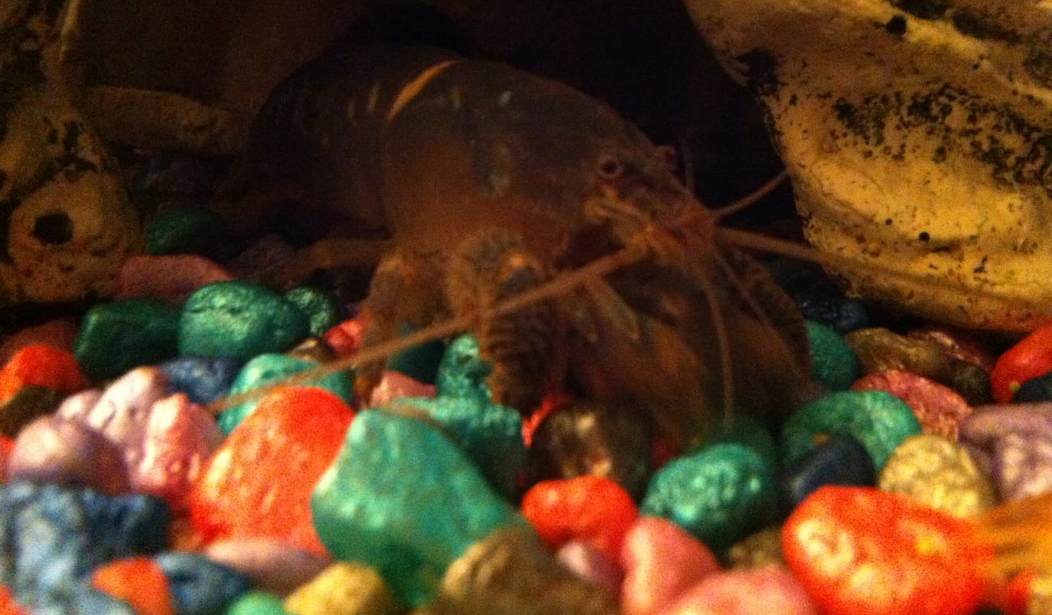Vampire Shrimp
Atya gabonensis
These giants can get up to six inches long, though my guy is between three and four inches, and wave their jazz hands to fan food from the substrate. Unlike the filter-feeder bamboo shrimp that like to dangle in the water column to pick off their food, the vampire likes to lumber along the ground — specifically, he likes having a cave as home base and will venture out when the lights are off if he feels the need to scavenge. Since I got mine a cave with an open top and side, as well as a narrow end to hide, and put it near the filter outflow, I rarely see the happy guy — except for an appreciative wave of feelers if I drop him some treats. Gets along well in a community tank and is imposing enough that no one tries to mess with him.
Spotted Headstander
Chilodus punctatus or Chilodus gracilis
These hovering fish are eye-catchers, even if their gaze is usually trained on what morsels may be lurking on the gravel or on that moss ball. They can grow up to 3.5 inches; mine is about 2.5 inches — and I have to vouch for his hardiness as he survived a bout of columnaris. These guys are generally a “one or six” fish: they can be aggressive with their own kind, which can be defused through numbers. My headstander is generally peaceful, but can get nippy during the most heated moments of competitive eating. I keep my tanks at 80 degrees, feed New Life Spectrum flakes in the morning, a rotation of frozen food in the evening and a few bottom-feeder tablets before bed, and the headstander will graze on it all.
Baby Whale
Brienomyrus brachyistius
This African elephantfish, or Mormyrid, is notable for its oversized brain and electrical impulses used to find food. I have a large cichlid tank, a calm community tank and a rowdy community tank, and the baby whale enjoys the rowdy, busy environment of tetras, guppies and the like as long as he has a cave of his own for retreat (and he’s not easy to photograph when constantly on the move or tucked away). He wasn’t easy to feed at first as he was too shy to be adequately competitive, so I put a cube of baby brine shrimp (they have small mouths) or krill in his cave before lights out. After a few weeks, he was coming out at feeding time to join everyone else — even nibbling on flakes, though their preference is live or frozen, with favorites including daphnia — and is very competitive to get his grub. I wouldn’t say he nips tankmates — nudges is more like it, with that snub-nose and tiny mouth.
Chocolate Gourami
Sphaerichthys osphromenoides
There are a few keys to keeping these beautiful fish happy: diffused lighting and shady spots, warm water, only slight water movement, calm tankmates, great water quality, and a variety of little foods to munch at (at their speed). They need places sheltered enough to feel secure, but I find the moment I bend up the light in the tank — angled to skim across the water instead of point down into it — and things get even shadier, this fish becomes more gregarious. He also doesn’t go to battle with any other gourami, or any other fish for that matter. They can grow a little more than two inches long.
Dwarf Mexican Crayfish
Cambarellus patzcuarensis
Love the look of crayfish in your tank but don’t like the idea of your dither fish disappearing one by one? I always keep one of these orange guys in my community tank (the rowdy one). In the large cichlid tank he’d become an appetizer, but with a community mix he’s fine — I even have ghost and amano shrimp in there, and he doesn’t bother them. When I had two mini crays in the same tank, there were dominance issues and one lost a claw. So now I keep one to a tank, where they grow to about 1.5-2 inches long and feast on goodies that have fallen to the substrate.
African Butterfly Fish
Pantodon buchholzi
When I look down into my South American cichlid tank and see this guy hovering on the water, it looks like the Silence of the Lambs moth is in my aquarium. The butterfly fish is interactive — he comes out every evening at bedtime so I can hand-feed him four New Life Spectrum floating pellets — and only really does battle with an upside-down catfish a little smaller than his size (about 4 inches) who occasionally tries to swipe those pellets. They are amazing jumpers so you want to keep a cover on things, though I’ve only seen him jump when startled by other fish or feeding time. He likes still water, which can be a challenge in a tank with filters on one end and a bubbler on the other, so I walled off an area with silk plants where he can surface-float with little disturbance. Length is better than depth for these fish, who like to skim back and forth. Don’t house with any fish that are tempted to nibble those fine, trailing fins.
Valentine Synodontis
Truth be told, visitors seeing my cichlid tank usually zero in on the two full-grown African featherfin cats (Synodontis Eupterus) who aren’t shy about greeting folks. My Valentine cats are a bit more shy, but when they peek out of their favorite PVC pipe hides people are similarly intrigued. These silvery cats aren’t as deep-bodied as the featherfins, have fine spots on the head and larger markings on the body, and stripes on the fins — well, at least that’s what one of my Valentine cats looks like. The other is more greenish-gold silver with different markings, and is about four inches long compared to about 6 inches for my pictured syno. They’re a hybrid, but of which synos nobody really knows. I started them, at different times, in a 20 gallon long because as babies they got picked on in the big tank, but they didn’t really thrive in a tank that small. As teens, they went back in the big tank and had nice growth spurts. They eat anything, and especially love the Hikari bottom-feeder wafers and Omega One veggie rounds.















Join the conversation as a VIP Member